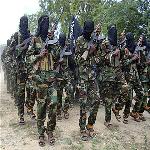07 September 2010

Photo: AP
Hard-line Islamist al-Shabab fighters conduct military exercise in northern Mogadishu's Suqaholaha neighborhood, Somalia, 5 Sep 2010
Over the past two weeks of fighting, the U.N. refugee agency reported more than 230 civilians have been killed and at least 400 people wounded.
Furthermore, it says 23,000 people have fled their homes, adding to the more than 200,000 civilians who already have become displaced this year.
UNHCR spokeswoman, Melissa Fleming, says people are becoming increasingly trapped in a war zone. She also said it is becoming more difficult and dangerous for people to flee from Mogadishu.
She said most of the people who manage to reach northern Somalia and neighboring countries are arriving on foot and in small buses.
"They tell our staff that the streets of Mogadishu are completely deserted and that people are too afraid to leave their houses," said Fleming. "One woman actually who escaped told us that 'all you see in the streets are bodies of people killed by bullets or mortars.' In these dangerous and difficult conditions, aid distributions are becoming rare and those who venture out are really risking their lives."
The UNHCR spokeswoman said people who leave Mogadishu face new risks and difficulties on their way to Somalia's Puntland region or Ethiopia and Kenya. She said some 7,300 Somalis have reached Yemen by boat this year. This is only half the number, however, that made it to Yemen a year ago.
She said the situation is similar in Kenya. She noted about 37,000 Somali refugees have arrived there this year, a much lower figure compared to last.
Fleming said, though, that 6,500 new Somali refugees arrived in Kenya in August, making this the highest monthly total since June.
"Those who do make it to the Kenyan border and register at the Dadaab refugee complex tell us that many people are staying inside the country in makeshift IDP (internally Displaced People) camps as they fear forced recruitment and abuse by militias operating in the south," said Fleming. "In addition, there is no transport and, when there is, many cannot afford the trip to the border. And, heavy rains there also have made many roads impassable."
UNHCR spokeswoman Fleming said Ethiopia is the only country in the region showing a continuing increase in the rate of Somali arrivals. She said more than 20,000 Somalis have sought safety and shelter there this year, bringing the total Somali refugee population to almost 76,000.